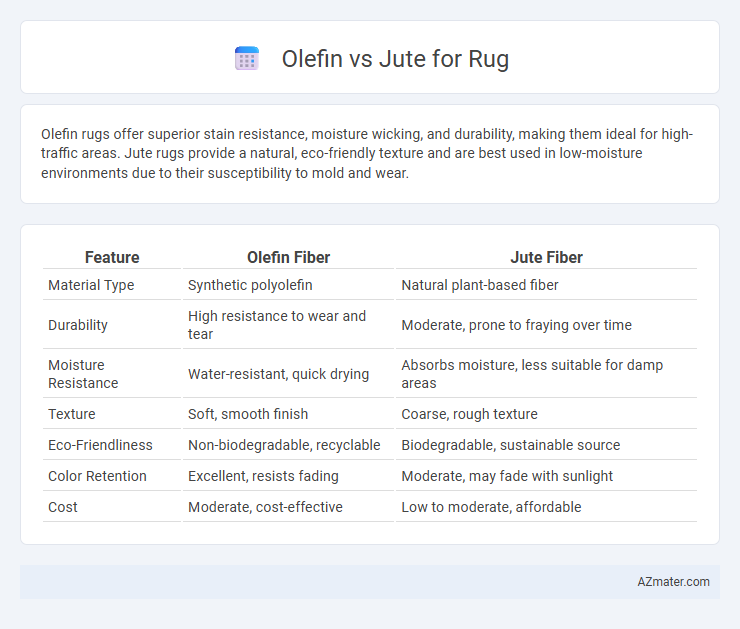Olefin rugs offer superior stain resistance, moisture wicking, and durability, making them ideal for high-traffic areas. Jute rugs provide a natural, eco-friendly texture and are best used in low-moisture environments due to their susceptibility to mold and wear.
Table of Comparison
| Feature | Olefin Fiber | Jute Fiber |
|---|---|---|
| Material Type | Synthetic polyolefin | Natural plant-based fiber |
| Durability | High resistance to wear and tear | Moderate, prone to fraying over time |
| Moisture Resistance | Water-resistant, quick drying | Absorbs moisture, less suitable for damp areas |
| Texture | Soft, smooth finish | Coarse, rough texture |
| Eco-Friendliness | Non-biodegradable, recyclable | Biodegradable, sustainable source |
| Color Retention | Excellent, resists fading | Moderate, may fade with sunlight |
| Cost | Moderate, cost-effective | Low to moderate, affordable |
Introduction: Understanding Olefin and Jute Rugs
Olefin rugs, made from synthetic polypropylene fibers, offer high resistance to moisture, stains, and fading, making them ideal for high-traffic or outdoor areas. Jute rugs, crafted from natural plant fibers, provide eco-friendly sustainability with a distinctive coarse texture and earthy aesthetic. Evaluating durability, comfort, and maintenance needs helps determine the best choice between the synthetic durability of olefin and the biodegradable appeal of jute.
Material Composition: Olefin vs Jute
Olefin rugs are crafted from synthetic polypropylene fibers known for their durability, moisture resistance, and stain repellency, making them ideal for high-traffic areas. Jute rugs consist of natural fibers derived from the jute plant, offering a soft, biodegradable, and eco-friendly option but with less resilience to wear and moisture. The material composition of olefin provides enhanced longevity and easy maintenance, while jute prioritizes natural texture and environmental sustainability.
Durability Comparison: Olefin and Jute Rugs
Olefin rugs exhibit superior durability compared to jute, with excellent resistance to moisture, stains, and fading, making them ideal for high-traffic areas and outdoor settings. Jute rugs, while biodegradable and eco-friendly, tend to wear down faster due to their natural fiber composition, showing vulnerability to mold and mildew in damp environments. The synthetic properties of olefin fibers contribute to their long-lasting performance, whereas jute requires careful maintenance to preserve its appearance and structural integrity.
Stain and Moisture Resistance
Olefin rugs offer superior stain and moisture resistance due to their synthetic fibers that repel water and prevent absorption, making them ideal for high-traffic or damp areas. Jute rugs, composed of natural plant fibers, are more susceptible to staining and moisture damage because they absorb liquids quickly and can develop mold or mildew if not properly maintained. Olefin's durability and easy cleaning make it a practical choice for areas prone to spills, while jute's aesthetic appeal requires careful handling to avoid moisture-related issues.
Comfort and Texture Differences
Olefin rugs provide a soft, smooth texture that feels cool and comfortable underfoot, making them ideal for high-traffic areas and warmer climates due to their moisture-resistant properties. Jute rugs feature a coarse, natural fiber texture that offers a rustic, earthy feel with moderate cushioning but can be rougher on bare skin. The inherent durability of olefin contrasts with the organic, biodegradable qualities of jute, influencing comfort levels based on fiber softness and tactile experience.
Eco-Friendliness and Sustainability
Olefin rugs are made from synthetic fibers derived from petrochemicals, offering durability but limited biodegradability and a higher environmental footprint due to fossil fuel reliance. Jute rugs, crafted from natural plant fibers, are biodegradable, renewable, and require fewer resources to produce, enhancing their eco-friendliness and sustainability. Choosing jute supports sustainable agriculture and reduces plastic waste, making it a preferable option for environmentally conscious consumers.
Maintenance and Cleaning Requirements
Olefin rugs resist stains, moisture, and mildew, making maintenance straightforward with regular vacuuming and occasional spot cleaning using mild detergent. Jute rugs require more careful upkeep due to natural fiber susceptibility to moisture damage and staining, best cleaned with dry methods like vacuuming and professional cleaning for deep stains. Olefin's synthetic nature provides superior durability and easier upkeep compared to the delicate, natural texture of jute.
Cost and Affordability
Olefin rugs typically cost less than jute rugs due to the synthetic nature of olefin fibers, making them a more budget-friendly option for consumers. Jute rugs, made from natural plant fibers, often have a higher price point reflecting their eco-friendly appeal and handmade quality. For affordability without sacrificing durability, olefin provides a cost-effective choice, whereas jute offers value through its organic materials and natural texture.
Best Uses and Room Placement
Olefin rugs excel in high-traffic areas such as living rooms, playrooms, and basements due to their stain resistance, moisture repellence, and durability. Jute rugs are ideal for low-traffic spaces like bedrooms, dining rooms, or home offices where a natural, textured aesthetic is desired without heavy wear. Olefin performs well indoors and outdoors, while jute should be kept dry to maintain its shape and longevity.
Conclusion: Choosing Between Olefin and Jute Rugs
Olefin rugs offer superior moisture resistance and stain durability, making them ideal for high-traffic and outdoor areas, while jute rugs provide natural texture and eco-friendly appeal but require careful maintenance to avoid wear and moisture damage. Olefin's synthetic fiber composition ensures colorfastness and easy cleaning, contrasting with jute's organic fibers that absorb moisture and are prone to fading. Selecting between olefin and jute rugs depends on balancing durability and environmental preference, with olefin favored for longevity and practicality and jute chosen for aesthetic sustainability.

Infographic: Olefin vs Jute for Rug
 azmater.com
azmater.com